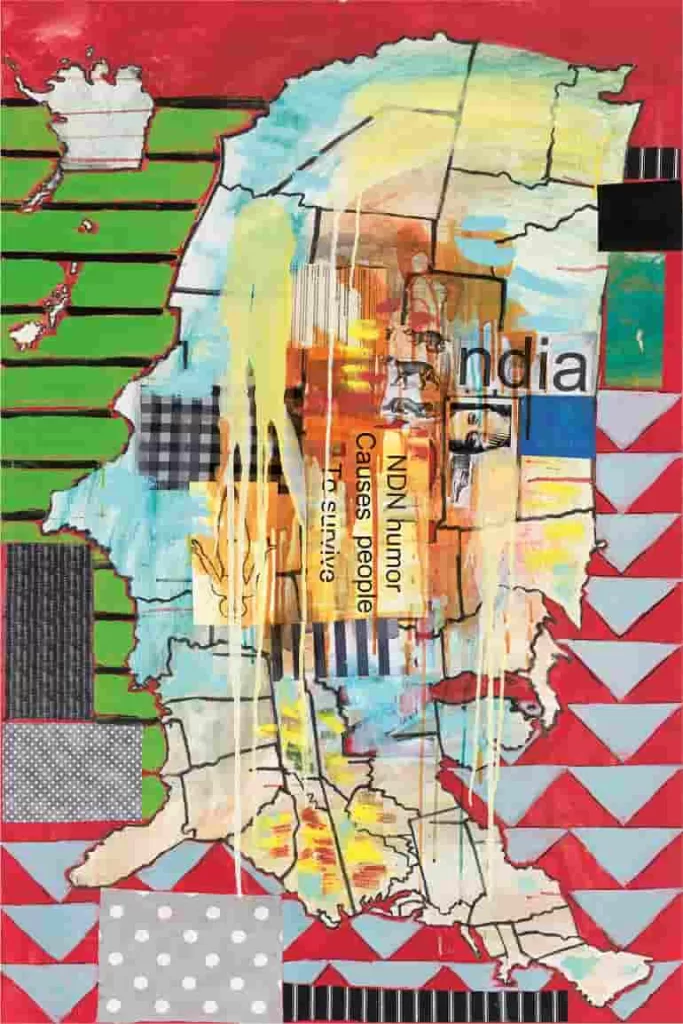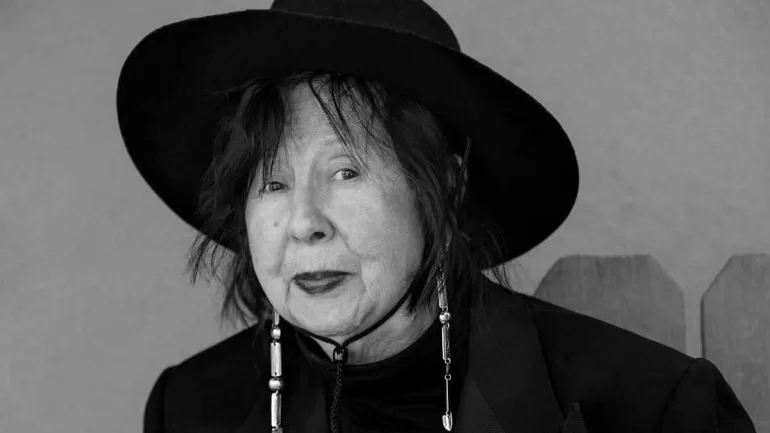ARTCENTRON CELEBRATED
Jaune Quick-to-See Smith’s work changed the art world. Her impact as a Native American artist, curator, and activist lives on.
BY KAZEEM ADELEKE, ARTCENTRON
Jaune Quick-to-See Smith, a trailblazing artist, curator, and activist, passed away early this year after a long and valiant battle with pancreatic cancer. She was 85 years old. Her death marks the end of an era for contemporary American art, particularly within the Native American art community, where she played a crucial role in shaping its future. Smith’s contributions extended beyond her striking artworks. She was into activism, and her curatorial practice often addressed profound issues of race, colonialism, and Native American rights.
The Legacy of Native American Artist Jaune Quick-to-See Smith
Born in 1940 on the St. Ignatius Indian Mission in Montana, Jaune Quick-to-See Smith belonged to the Confederated Salish and Kootenai Nation. As an artist, Smith explored the complexities of Native American identity, survival, and resistance to the oppressive structures of colonialism. Through her mixed media works, including expressive paintings and collages, she used Indigenous symbolism to confront the harsh realities faced by Native peoples in modern America.
Jaune Quick-to-See Smith‘s artistic journey was marked by a unique fusion of Native traditions with contemporary art movements. Her works often drew inspiration from Native beadwork, ancient petroglyphs, and natural elements, incorporating symbols such as canoes and buffalo. She didn’t just recreate these images but redefined their significance, using them to challenge American cultural norms. In her hands, these symbols became a medium for calling attention to the overlooked Native presence in the nation’s narrative.
Her approach to art was highly influenced by artists like Joan Mitchell and Robert Rauschenberg, whose use of abstraction and collage techniques resonated with Smith’s creative process. Through this combination of Indigenous iconography and modernist techniques, Smith carved out a distinctive place in the art world, earning recognition both within Native American communities and in the broader contemporary art scene.
A Career Devoted to Curating and Promoting Native Art
Jaune Quick-to-See Smith was not only a prolific artist but also a dedicated curator and promoter of Native American art. Her commitment to uplifting Native voices in the art world was unwavering. She spent much of her career working to ensure recognition for the contributions of often overlooked Native artists. One of her major achievements was the curation of Women of Sweetgrass, Cedar, and Sage (1985), a groundbreaking exhibition that focused on the work of Native American women artists.
This exhibition was important in reshaping the narrative around Native American art, showcasing the diverse and powerful voices of women artists who had been historically marginalized. Smith’s curatorial efforts did not stop there; she went on to organize and curate over 30 exhibitions throughout her career, including the landmark The Land Carries Our Ancestors in 2023, which featured nearly 50 contemporary Native American artists.
One of Smith’s final curatorial projects, Indigenous Identities, opened recently at the Zimmerli Art Museum in New Brunswick, New Jersey. The exhibition includes works by 90 living Native artists. It offers a powerful exploration of Indigenous self-representation and the continued importance of Native American art in shaping cultural conversations.
Her curatorial work often focused on the themes of land, identity, and survival. The Land Carries Our Ancestors brought together a diverse group of artists who used various mediums. From beadwork and sculpture to photography and video, the artists explore Indigenous knowledge of the land. Through this exhibition, Smith reinforced the idea that Native peoples possess a deep, spiritual connection to the land, one that has been passed down through generations.

Smith’s Advocacy for Native American Artists
In addition to her curatorial achievements, Jaune Quick-to-See Smith was a tireless advocate for the recognition of Native American artists. She dedicated her life to breaking down the barriers faced by Indigenous artists in the American art world. Her effort helped pave the way for future generations of Native creators.
Her advocacy efforts were not only focused on securing opportunities for Native artists to exhibit their work but also on ensuring that their stories and perspectives were heard and understood. Smith’s work as a curator and mentor helped to shift the art world’s perception of Native American art. She was able to move it beyond the confines of “ethnographic” art, elevating it to a level of mainstream recognition.
Throughout her career, Jaune Quick-to-See Smith received numerous prestigious awards. They include the Women’s Caucus for the Arts Outstanding Lifetime Achievement in the Visual Arts Award and the Eiteljorg Museum Fellowship for Native American Fine Art. These accolades are a testament to her immense contributions to the art world and the Native American community. She had honorary doctorates from several esteemed institutions. These honors further cement her legacy as one of the most important Native American artists and curators of her time.
In 2023, Smith became the first Native artist to have a retrospective at the Whitney Museum of American Art. This epochal achievement celebrated her work and also recognized the broader impact of Native American artists on contemporary art. This milestone is a powerful statement about the value and importance of Native American contributions to the global art landscape.
Jaune Quick-to-See Smith’s Enduring Cultural Impact
Jaune Quick-to-See Smith’s influence extends far beyond her lifetime. Her work, both as an artist and as an advocate for Native American representation in the arts, has inspired countless individuals. By confronting the legacy of colonialism, race, and cultural erasure, Smith’s art challenges us to reconsider the dominant narratives of American history.
Her impact is evident in the growing institutional recognition of Native American artists. Many of them benefited from her pioneering efforts to promote Indigenous art. As the art world continues to evolve, Smith’s legacy will endure, inspiring future generations of artists and curators. This new generation will carry forward her mission to celebrate and give credence to Native American voices.
Smith’s dedication to education and mentorship was evident throughout her career. She taught at various institutions, giving Native American artists the tools and knowledge they needed to succeed in the art world. Her commitment to sharing knowledge extended beyond formal education. She was a major source of encouragement to the new generation of artists. She wrote letters of encouragement to fellow artists and organized grassroots events to support the Native art community.
Her philosophy, drawn from her Salish heritage, emphasized the importance of reciprocal relationships. For her, teaching and learning from one another in a spirit of mutual respect is important. Her art and curatorial work reflected this mindset. Throughout her career, she sought to create platforms for Native artists to share their stories and work with the world.
Jaune Quick-to-See Smith’s Enduring Influence on the Art World
Jaune Quick-to-See Smith’s passing marks the end of an era. However, her legacy will continue to shape the art world for years to come. Through her innovative art, her curatorial work, and her tireless advocacy for Native American artists, Smith changed the landscape of contemporary art. She was more than just a groundbreaking artist. Jaune Quick-to-See Smith was also a visionary who created space for Indigenous voices. More importantly, she fought vehemently for the recognition of Native American art.
Her life’s work is a powerful reminder of the resilience of Native peoples and their ongoing contributions to the cultural fabric of America. Jaune Quick-to-See Smith’s influence will continue to impact future generations of artists, curators, and art lovers. They will continue her mission of representation, empowerment, and self-expression.
